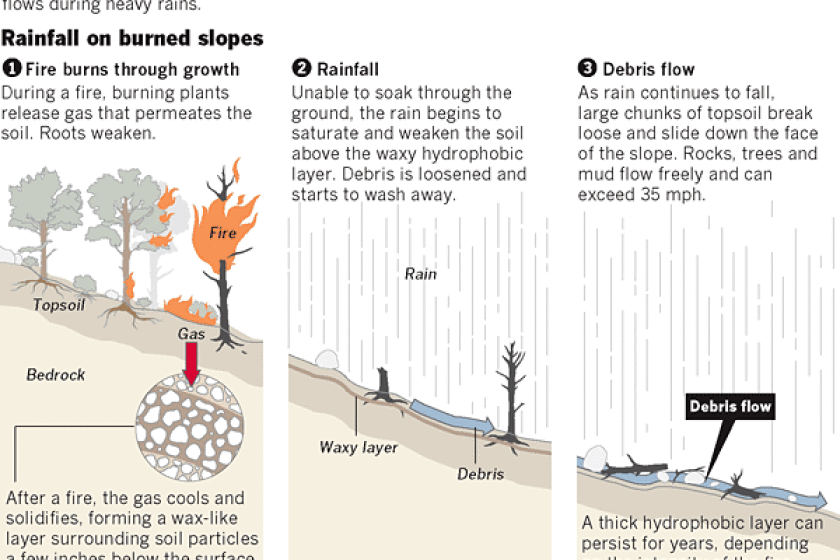California braces for intense rain, renewing concerns about mudslides in burn areas

- Share via
A strong storm that was poised to descend on portions of the state by midday Tuesday is prompting concerns about flash flooding and debris flows in recent burn areas.
The cold front, which originated in the Gulf of Alaska, was expected to reach the northern fringes of the San Francisco Bay Area around noon and push south into San Francisco by late afternoon. Most areas will see half an inch to 2 inches of rain. The heaviest rainfall will occur between 5 and 10 p.m., according to the National Weather Service.
Forecasters issued a flash flood watch from 2 to 10 p.m. for the portion of northern Sonoma County struck a month ago by the Kincade fire. The blaze charred nearly 78,000 acres and destroyed more than 370 homes in the region.
Meteorologists are warning of moderate to briefly heavy rainfall rates of a half-inch to three-quarters of an inch per hour, bringing the potential for flash flooding, rockslides and debris flows in the burn area. Officials urged residents to monitor weather reports and be prepared to take action if a flash flood warning is issued.
The rain will likely hit the Central Coast by midnight before moving into Los Angeles County by sunrise on Wednesday. The storm is expected to dump one to two inches of precipitation in the coast and valleys, and up to three inches in the foothills and lower elevations of the mountains, said Kristen Stewart, a meteorologist with the National Weather Service in Oxnard.
“There’s likely going to be heavy rain for the morning commute in Los Angeles tomorrow, so people should be prepared for that,” she said.
The storm also brings the potential for debris flows in burn-scarred areas in Southern California, including the San Fernando Valley region affected by the Saddleridge fire and the Easy fire in Simi Valley.
There’s a slight chance of thunderstorms Thursday with brief pockets of heavy rain. Sustained precipitation could cause mudslides in burn areas, the weather service warned.
Damage from wildfire prevents soil in recently burned areas from absorbing rainwater. Enough rain can lead to fast-moving flows that contain mud, debris, trees and boulders that can be several feet deep and deadly for those in their path. The devastation often comes without warning.
Such a scenario followed the Thomas fire, which charred more than 281,000 acres in Santa Barbara and Ventura counties in 2017. Heavy rains in January 2018 led to devastating flooding in Montecito that blanketed the community in mud, destroyed homes and claimed at least 20 lives.
Flash flood watches will also be in effect from late Tuesday through Thursday evening for higher elevations in Southern California, including in Riverside, San Bernardino and San Diego counties.
“Locally heavy rainfall could produce flash flooding, with the greatest threat to steep terrain, especially in and below recently burned areas,” the weather service said. “Flooding of poorly drained and urban areas will also occur, presenting a hazard for motorists.”
Despite the flooding risks, officials are hoping the rain brings an end to the state’s fire season.
Much of California has been unusually dry so far this autumn, keeping fire danger high. Some of California’s most destructive recent fires have hit during November and December when normal seasonal rainfall has been absent, such as the Camp fire that ignited on Nov. 8, 2018, and destroyed much of the town of Paradise, killing more than 80 people.
And on Monday, a fast-moving brush fire erupted and was threatening thousands of homes in Santa Barbara County. The Cave fire was being pushed down from Los Padres National Forest toward communities in Santa Barbara and Goleta by powerful winds. The blaze swelled to more than 4,000 acres overnight, and crews were hoping they could keep flames away from nearby homes until the rains arrived.
“What’s working in our favor is we’re getting rain tonight,” said Santa Barbara County Fire Capt. Daniel Bertucelli.
More to Read
Sign up for Essential California
The most important California stories and recommendations in your inbox every morning.
You may occasionally receive promotional content from the Los Angeles Times.













